I am a gadget freak, often purchasing new technologies in their first release. And my closet is full of such gadgets, from early pen-based computers to early brick-sized cell phones to an electronic handwriting recognition pad received as a gift to test. These early dives into new technologies serve a purpose for me. They keep me at the leading edge of new development as it is productized, even before mass production. They allow me to preview new devices and technologies before release so that I might write about and speak about them in my “Tech Trends” keynotes. And they are always the center of attention with my tech-savvy friends, some of whom are in the habit of asking, “So what’s new today” each time we meet.
Cost to the user and to the producer
The cost of such attention-seeking and research is relatively low for me, and certainly the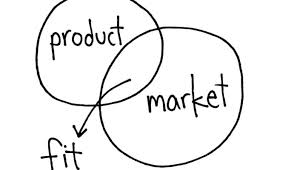 reward of being sought out as a speaker addressing the trends in technology is enough in itself.
reward of being sought out as a speaker addressing the trends in technology is enough in itself.
But I have been on the other side of the early adopter development process several times in the past, and can attest that it is great fun, but rarely profitable to be the first with any new product that requires simultaneously evangelizing or teaching the masses within the industry and marketing the new product offering. The costs in playing such a dual role are many times that of those in positioning a new product in a niche already opened by another. And statistically, the first product into a niche is very rarely the one to succeed.
Some great examples of second-to-market
Apple, for example, was nowhere near the first to introduce an MP3 handheld music player. I had owned several before the first iPod was released. Apple learned that their leverage was in the simultaneous creation of an easy-to-use retail music store for seamlessly downloading songs, podcasts and later applications to the device. It did not hurt that Apple always seemed to trump the competition in design of the product and the product’s user interface too.
My “way too early” story
 In 1986, while in the hotel technology business, I observed the back-room success of American Airlines with their new Sabre subsidiary and its creation of a “yield management” system to use massive data to project demand for an airline seat on an individual flight segment days and months into the future. I was not alone among hotel industry executives curious for more information. And Sabre was not talking to anyone about their magic potion.
In 1986, while in the hotel technology business, I observed the back-room success of American Airlines with their new Sabre subsidiary and its creation of a “yield management” system to use massive data to project demand for an airline seat on an individual flight segment days and months into the future. I was not alone among hotel industry executives curious for more information. And Sabre was not talking to anyone about their magic potion.
[Email readers, continue here…] First Hyatt Hotels, then Marriott Corporation called me to their respective headquarters to consult with their executives on this subject under a non-disclosure with each. I became even more excited about the concept applied to the hotel industry. Both of those chains had very primitive modules in their respective reservation systems. Marriott called theirs “tier pricing”. If a future date was already booked at 80%, then they would eliminate any discounts below 10% from the “rack” or standard room rate. At 90% they would stop discounting entirely. These elementary steps were in the right direction but very primitive.
Seizing a too-early opportunity
So, I set about partnering with a small group of MIT graduates to produce specialized decision software for the hotel industry using the “LISP” programming language, created just for decision-making, allowing for coding inductive and deductive logic into the software. I partnered with Texas Instruments, producer of a LISP computer, the TI Explorer. We designed and produced special cards for the TI that would allow Apple Macintosh workstations to be used, with their handsome graphic user interface.
Then I designed what was then a ground-breaking new software system that could analyze tons of data from past guest stays on the same date a year earlier and other dates with the same day of week, add factoring for city-wide events on any future date such as pro football games and conventions, analyze the speed of increase in any night’s future reservations, and much more.
How it worked
Each night, the system was designed to perform its analysis using real advanced reservations data current to the moment and run the data through a series of rules I wrote which could be modified or added to by local hotel management, to automatically make pricing decisions and automatically implement them. The system coordinated decisions between the reservations department which accepted individual or transient reservations and the group sales department booking groups at a discounted rate, allocating available rooms between each to achieve maximum revenue for any future date.
Our test sites
I found a willing test site in the Royal Sonesta Hotel in Cambridge, Massachusetts, whose management was thrilled to participate in an industry-changing experiment with new technology. The system was priced at $150 thousand, but we calculated that the average decision implemented for the 300-room property should be worth $5 thousand, making payback within an amazing 60 days if all worked as planned. Our company installed the system, integrated it with the Sonesta computer system which our company had previously provided, trained the staff, and began to measure the results after turning on the system in a live environment. In the meantime, we sold a second system to a large timeshare resort in Orlando for the same price. By agreement, Sonesta withheld payment until completion of the beta test period.
The real test: The industry trade show
The industry’s annual technology trade show came up during these tests. The industry 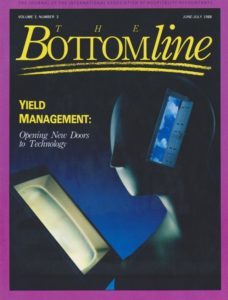 was abuzz about this “artificial intelligence” system and its purported early results, and I wrote the cover story for the industry magazine about the system, and organized a panel composed of executives from Sonesta, Marriott and other chains to present and discuss this newest industry marvel. On the day and hour of the panel, it became obvious that the house was way overbooked. We agreed to repeat the panel later that day for the hundreds of people unable to get into the large room. We were a great success with a great, ground-breaking product.
was abuzz about this “artificial intelligence” system and its purported early results, and I wrote the cover story for the industry magazine about the system, and organized a panel composed of executives from Sonesta, Marriott and other chains to present and discuss this newest industry marvel. On the day and hour of the panel, it became obvious that the house was way overbooked. We agreed to repeat the panel later that day for the hundreds of people unable to get into the large room. We were a great success with a great, ground-breaking product.
Reality trounces early vision
And the next week we asked for payment from the test property, after sign-offs from all its managers but the top one. The general manager was also an executive of the family chain of hotels. He called me in, along with several of the second level managers so enthused about the system, and stated, “This is nice, but I could do this work on the back of a napkin,” shocking us all, and he refused the pay for the machine. I challenged him immediately.
“Let’s disconnect the system from influencing the reservation system for one week,” I offered, “and let the machine calculate but not implement its decisions. During that week, you make your decisions each night on the back of your napkin. At the end of the week, we’ll compare the effectiveness of each. If you agree that our system was more likely to positively affect revenues on those dates targeted, you pay for the system. If not, we’ll remove the test system and find another home for it.”
He agreed. Management added a few new rules to the rule base and watched over the system each evening, anxious that there be no contest between this number-crunching wonder and a single manager’s intuitive guesses.
The moment of truth: Facing the “no decision” competition
A week later, I again traveled across the country to the property to meet with the same team and the general manager. We printed out the week’s decisions, those not implemented. We presented our findings. And waited for the GM’s response. “I did not bother,” he stated. “I have no doubt that I could have done this better if I’d taken the time; but I was busy this week.”
The final lesson: Too early to market is a fatal mistake
We could not argue with the money, even if we were right and all other managers desperately wanted to keep the wonder machine. So, we removed the system. After all that great press, I realized that the industry just was not ready for such a leap, giving up authority to a computer, even if at least one major airline had successfully done so. I offered to repurchase the second machine from the hotel in Florida. After all, what company can maintain such a small number of unique systems?
Our mundane, but profitable solution
I turned to Tom, our chief programmer, and directed him to use as many of the features of the knowledge based (artificial intelligence) system as possible, but to be reprogrammed into our standard reservations module using our BASIC programming language. Tom’s team did just that, perhaps saving 70-80% of the functionality even if none of the leading-edge glitz. We priced the reduced “feature” at $8,000 – and sold many over the years as mere add-ins to the reservation system.
After spending over a half million on the project (and receiving at least that in great publicity), I learned a lesson. It is satisfying but rarely profitable to cater to early adopters.

 much more deeply than during the development process, unveiling many possible consequences to be considered before implementation of an idea or project. When I use this technique, invariably the person on the other side of the question will at some point state, “I didn’t think of that.”
much more deeply than during the development process, unveiling many possible consequences to be considered before implementation of an idea or project. When I use this technique, invariably the person on the other side of the question will at some point state, “I didn’t think of that.”
 more and more difficult to know the pulse of the industry, which becomes more and more risky as decisions are made and resources allocated to projects or products that may no longer be as attractive as before.
more and more difficult to know the pulse of the industry, which becomes more and more risky as decisions are made and resources allocated to projects or products that may no longer be as attractive as before.  young companies, small entrants find themselves. See what new ideas they have that are unaffected by the norms of bigger competitors. (As an early stage investor, this is the first place I head during a trade show.) Then, attend a few of the most interesting sessions to find what’s new. You’ll be refreshed and perhaps surprised.
young companies, small entrants find themselves. See what new ideas they have that are unaffected by the norms of bigger competitors. (As an early stage investor, this is the first place I head during a trade show.) Then, attend a few of the most interesting sessions to find what’s new. You’ll be refreshed and perhaps surprised.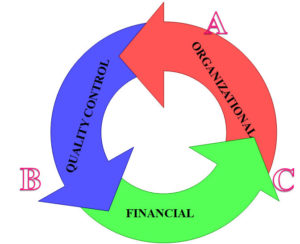 their early revenue period. A very predictable series of rotating crises seemed to befall most every one of these young companies. These became so predictable that I could accurately label them as occurring about every $3 million in gross profit (or revenue for service companies). By defining this in terms of gross profit, we can include distributors with 15% gross margins as easily as software companies boasting nearly 100% gross margin.
their early revenue period. A very predictable series of rotating crises seemed to befall most every one of these young companies. These became so predictable that I could accurately label them as occurring about every $3 million in gross profit (or revenue for service companies). By defining this in terms of gross profit, we can include distributors with 15% gross margins as easily as software companies boasting nearly 100% gross margin.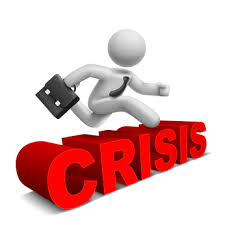 At about the $6 million mark, in my experience, revenues have ramped to the extent where the original product standards of quality are challenged, as is the speed and efficiency of customer service. Changes need to be made quickly to preserve the reputation of the company, adding a quality control function if not present, adding more QC steps in the process, addressing the number of customer service people on the line, creating longer hours to serve a larger customer base.
At about the $6 million mark, in my experience, revenues have ramped to the extent where the original product standards of quality are challenged, as is the speed and efficiency of customer service. Changes need to be made quickly to preserve the reputation of the company, adding a quality control function if not present, adding more QC steps in the process, addressing the number of customer service people on the line, creating longer hours to serve a larger customer base. others who emphasize service or quality. There are exceptions, based upon cost of sales. For example, Internet resellers have a better chance to combine price and quality than those with much more fixed overhead occupying a bricks-and-mortar physical presence in the community.
others who emphasize service or quality. There are exceptions, based upon cost of sales. For example, Internet resellers have a better chance to combine price and quality than those with much more fixed overhead occupying a bricks-and-mortar physical presence in the community. The very image of a company is influenced by your niche decision, as is every decision following it. In many markets, there are poorly defended niches, even markets with dominant players. For example, the tech company, Asus, found this golden opportunity in the notebook market and moved in quickly to overtake all other manufacturers with low prices.
The very image of a company is influenced by your niche decision, as is every decision following it. In many markets, there are poorly defended niches, even markets with dominant players. For example, the tech company, Asus, found this golden opportunity in the notebook market and moved in quickly to overtake all other manufacturers with low prices. product or service one that responds to a customer need, real or perceived? This question deals with the of
product or service one that responds to a customer need, real or perceived? This question deals with the of describing benefits as a good sales person does. What the product does is less important than why the product solves the customer’s problem, and how the product does so in ways obviously better than the competitor’s product. This story should never be left to the sales person to make up, or each will make a different story for the purpose of a sale, not always aligned with the company’s market positioning and rarely as precise and compelling as that created by professional marketers.
describing benefits as a good sales person does. What the product does is less important than why the product solves the customer’s problem, and how the product does so in ways obviously better than the competitor’s product. This story should never be left to the sales person to make up, or each will make a different story for the purpose of a sale, not always aligned with the company’s market positioning and rarely as precise and compelling as that created by professional marketers.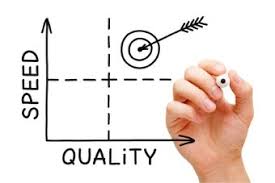 is acceptable but not discernibly above the competition. Or one of the instant auto service companies where an oil change is fast and inexpensive, but the number of inspection points far fewer than at a dealer location. Speed above quality.
is acceptable but not discernibly above the competition. Or one of the instant auto service companies where an oil change is fast and inexpensive, but the number of inspection points far fewer than at a dealer location. Speed above quality.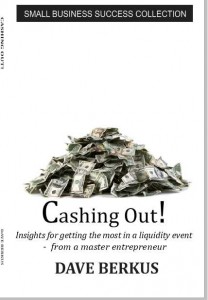
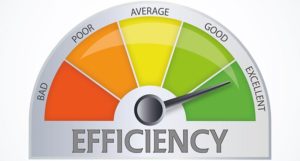 can. Either way, someone must start with creating a map of steps from start to completion, breaking it down to measurable sized increments. Look first at whether some steps are creating a bottleneck or quality breakdown affecting subsequent steps. If improving individual steps is not the solution, then scrap the process entirely and attempt to define a way to meet the goal through a differing route, such as outsourcing parts or the entire process, doubling the capacity of a segment of production, or redefining the goal itself.
can. Either way, someone must start with creating a map of steps from start to completion, breaking it down to measurable sized increments. Look first at whether some steps are creating a bottleneck or quality breakdown affecting subsequent steps. If improving individual steps is not the solution, then scrap the process entirely and attempt to define a way to meet the goal through a differing route, such as outsourcing parts or the entire process, doubling the capacity of a segment of production, or redefining the goal itself.